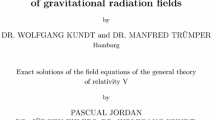Summary
Some properties of the universal gravitational field are derived by using the supposed observational equivalence with the apparent universal velocity field. It is found that de Broglie's hypothesis about the wave nature of matter indicates that there exist two different kinds of fundamental waves in Nature, to be named de Broglie's waves of first and second order, respectively. Of these waves the first one is a universal wave travelling at the constant velocityc 0, while the second can be reflected and travels at the velocity of light which depends on the aether density. It is conjectured that de Broglie's waves of second order reflect on the knots of de Broglie's waves of first order. The Larmos slowing down of clocks and the Fitzgerald-Lorentz contraction of bodies are considered as caused by the universal action of the homogeneous aether field. A formula for the aether density around a point mass is derived.
Riassunto
Si derivano alcune proprietà del campo gravitazionale universale usando la supposta equivalenza osservazionale con l'apparente campo di velocità universale. Si è trovato che l'ipotesi di de Broglie riguardo alla natura ondulatoria della materia implica che esistano due diversi tipi di onde fondamentali in natura, chiamate onde di de Broglie rispettivamente di primo e di secondo ordine. Di queste onde, la prima è un'onda universale che viaggia a velocità costantec 0, mentre la seconda può essere riflessa e viaggia alla velocità della luce che dipende dalla densità dell'etere. Si ipotizza che le onde di de Broglie di second'ordine si riflettano su gruppi di onde di de Broglie di prim'ordine. Lo scivolamanto degli orologi di Larmor e la contrazione dei corpi di Fitzgerald-Lorentz sono considerati come causati dall'azione universale del campo di etere omogeneo. Si deriva una formula per la densità dell'etere intorno ad una massa puntiforme.
Резюме
Выводятся некоторые свойства универсального гравитационнго поля, используя предполагаемую наблюдаемую эквивалентность с видимым универсальним полем скоростей. Получается, что гипотеза де ъройля относительно волновой природы вещества подразумевает, что существуют два различнех типа фундаментальных волн в природе, называемых соответственно волнами де ъройля первого и второго порядков. Первая волна является универсальной волной, распространяющейся с постоянной скоростьюc 0, тогда как вторая волна может отражаться и распространяться со скоростью света, которая зависит от плотности эфира. Предполагается, что волны де ъройля второго порядка отражаются от узлов волн де ъройля первого порядка. Рассматриваются замедление хода часов Лармора и сокращение тел Фитжеральда-Лоренца, обусловленные универсальным действием однородного поля эфира. Выводится формула для плотности эфира вблизи точечной массы.
Similar content being viewed by others
References
T. Sjödin:Z. Naturforsch. Teil A,37, 401 (1982).
T. Levi-Civita:The Absolute Differential Calculus (London, 1927).
H. Reichenbach:Philosophie der Raum-Zeit Lehre (Berlin, 1928).
M. F. Podlaha:Indian J. Theor. Phys.,23, 70 (1975).
T. Sjödin:Nuovo Cimento B,51, 229 (1979).
L. de Broglie:Matière et Lumière (Paris, 1937). Note, however, that de Broglie's concept of waves associated to particles is a bit different from our concept of material waves. So, for example, does de Broglie's concept not allow the association of a wave-length to a particle at rest, whereas this is indispensable at our concept of the wave nature of matter.
M. F. Podlaha:Indian J. Theor. Phys.,25, 87 (1977).
M. F. Podlaha:Indian J. Theor. Phys.,28, 19 (1980).
P. A. Ivert, T. Sjödin:Acta Phys. Acad. Hung.,48, 439 (1980);T. Sjödin:Z. Naturforsch., Teil A,35, 997 (1980).
G. Cavalleri, Ø. Grøn:Lett. Nuovo Cimento,18, 508 (1977).
K. R. Popper:Conjectures and Refutations (London, 1963).
Author information
Authors and Affiliations
Additional information
Traduzione a cura della Redazione.
Переведено редакцией.
Rights and permissions
About this article
Cite this article
Podlaha, M.F., Sjödin, T. On universal fields and de Broglie's waves. Nuov Cim B 79, 85–92 (1984). https://doi.org/10.1007/BF02723840
Received:
Published:
Issue Date:
DOI: https://doi.org/10.1007/BF02723840




